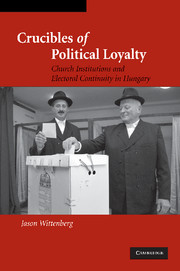Book contents
- Frontmatter
- Contents
- List of Figures
- List of Tables
- Acknowledgments
- INTRODUCTION
- 1 EXPLAINING POLITICAL PERSISTENCE
- 2 ELECTORAL PERSISTENCE AND VOLATILITY IN HUNGARY
- 3 THE CHURCHES FIRST CONFRONT COMMUNISM
- 4 THE BATTLE FOR SOULS, 1948–1956
- 5 THE BATTLE FOR SOULS AFTER 1956
- 6 CHURCH COMMUNITY AND RIGHTIST PERSISTENCE: STATISTICAL EVIDENCE
- 7 CONCLUSION
- Appendices
- Bibliography
- Index
- Titles in the series
2 - ELECTORAL PERSISTENCE AND VOLATILITY IN HUNGARY
Published online by Cambridge University Press: 02 September 2009
- Frontmatter
- Contents
- List of Figures
- List of Tables
- Acknowledgments
- INTRODUCTION
- 1 EXPLAINING POLITICAL PERSISTENCE
- 2 ELECTORAL PERSISTENCE AND VOLATILITY IN HUNGARY
- 3 THE CHURCHES FIRST CONFRONT COMMUNISM
- 4 THE BATTLE FOR SOULS, 1948–1956
- 5 THE BATTLE FOR SOULS AFTER 1956
- 6 CHURCH COMMUNITY AND RIGHTIST PERSISTENCE: STATISTICAL EVIDENCE
- 7 CONCLUSION
- Appendices
- Bibliography
- Index
- Titles in the series
Summary
Introduction
This chapter explores trends in Hungarian electoral behavior between 1945 and 1998. Its purpose is to “pin down the numbers” on Hungarian continuity and discontinuity. The highly disaggregated database I have constructed permits a far more detailed examination of the many paths between pre- and postcommunist partisan attachments than has ever been possible. We will discover significant continuities in support for the Right, but also see how the postcommunist liberal bloc fashioned its support out of fragments of the old leftist and rightist constituencies. Section 2.2 provides a brief introduction to democratic politics in Hungary before communism and identifies the political blocs that will form the basis of analysis. Section 2.3 introduces postcommunist blocs, explains the shift from a three-bloc to a two-bloc system between the 1994 and 1998 national parliamentary elections, and discusses aggregate-level electoral results for all blocs between 1945 and 1998. Section 2.4 briefly reviews existing methods for comparing the results of two elections and proposes a new one that is tailored for elections that are far apart in time.
Precommunist Blocs and Elections
Although electoral politics in Hungary go back well into the nineteenth century, the most reliable, detailed snapshot we have of precommunist partisan preferences within the electorate comes from the mid-1940s, just after World War II and before the advent of state-socialism. Hungary had two national parliamentary elections, in November 1945 and August 1947, between the time Hungary was liberated in early 1945 and the formal abolition of democratic politics in 1949.
- Type
- Chapter
- Information
- Crucibles of Political LoyaltyChurch Institutions and Electoral Continuity in Hungary, pp. 55 - 75Publisher: Cambridge University PressPrint publication year: 2006



